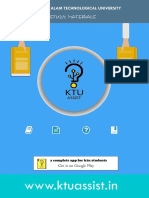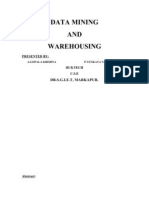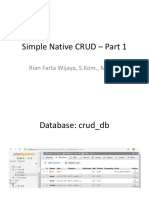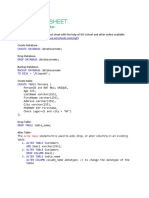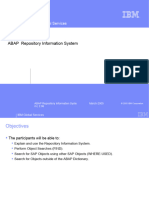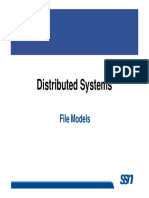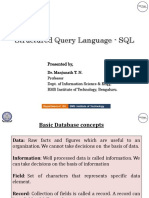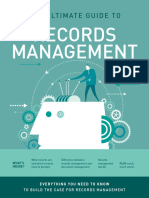Data Mining: Techniques, Applications, and Future Trends
Your Name
Designation
Email
Abstract
Data mining is the procedure of discovering meaningful patterns and differences within large
datasets using statistical and computational techniques and tools. Automated and semi-
automated techniques are used in data mining to analyse of large volumes of data to discover
hidden patterns, associations, anomalies. It has become an essential tool across different
fields including business, education, healthcare, and cybersecurity. This paper explores the
fundamental concepts of data mining, the various techniques used in it, the real-world
applications, and emerging trends in this fields; such as the integration of artificial
intelligence and big data analytics. The paper also describes the key challenges, including
data privacy, data quality, and model interpretability.
1. Introduction
In the era of big data, organizations and researchers are increasingly reliant on methods that
can automatically extract useful, relevant and meaningful data from vast amounts of
information. Data mining used automated or semi-automated analysis of large volumes of
data to discover hidden patterns, associations or predictive models that are not immediately
obvious. It is a step in the Knowledge Discovery in Databases (KDD) process. It also
involves techniques from machine learning, statistics, and database systems and applied to
both structured and unstructured data.
Data mining bridges the gap between raw data and actionable knowledge. As part of the
broader field of knowledge discovery in databases (KDD), data mining involves analysing
large datasets to uncover patterns that would be impossible to find manually.
Data mining is like digging through huge amounts of data to find useful patterns, just like
finding gold nuggets in a mountain of rocks. There are several smart techniques to do this,
each with its own purpose. For example, classification helps sort data into categories we
already know, like separating emails into "spam" or "not spam." Tools like Scikit-learn,
Weka, or RapidMiner help build these classification models easily. Then there's clustering,
which is like organizing a messy drawer grouping similar things together even if we don’t
know what the groups should be ahead of time. It is widely used in customer segmentation
and works well with tools like Python, R, and even Excel plugins.
Association rule mining is all about finding interesting connections between things like when
you notice that people who buy bread often buy butter too. This technique uses smart
algorithms like Apriori and can be done using tools like Orange, ML-xtend, or Weka.
Regression is used when we want to predict numbers, such as estimating someone’s salary
based on their education and experience. Tools like R, Python, and Excel make it easy to run
regression models. Lastly, anomaly detection helps catch unusual beaverlike spotting a
sudden big charge on your credit card that might be fraud. Tools like Py-OD, Scikit-learn, and
platforms like IBM SPSS are often used for this.
2. Literature Review
Han, Kamber, and Pei (2012) emphasis on data preprocessing techniques such as data
cleaning, integration, reduction, and transformation highlighting the importance of preparing
quality data before any mining task can be effectively performed. This sets it apart from
�many other texts that focus mainly on modelling without addressing upstream data
challenges. Witten, Frank, and Hall (2016) explain the inclusion of evaluation techniques
such as cross-validation, confusion matrices, ROC curves, and cost-sensitive learning
essential for understanding the strengths and limitations of different models. Aggarwal (2015)
presents a comprehensive overview of the foundational and advanced techniques in data
mining. In the study classical techniques such as decision trees and k-means clustering are
discussed alongside more advanced methods like density-based clustering (DBSCAN) and
frequent pattern growth algorithms (FP-Growth). This dual perspective provides a robust
framework for understanding both the mathematical underpinnings and practical applications
of data mining approaches. Fayyad, Piatetsky Shapiro, and Smyth (1996) is considered a
foundational contribution that formally articulated and popularized the concept of Knowledge
Discovery in Databases (KDD). The field of data mining was emerging in response to the
rapid growth of digital data and the need to extract useful insights from vast and often
unstructured datasets. This research aimed to provide a clear, comprehensive definition of
what knowledge discovery entails, emphasizing that data mining is not a stand-alone task, but
one step in an iterative, multi-stage process of extracting actionable knowledge from data.
3. Data Mining Process
Data mining is not just about applying algorithms to large datasets it is a multi-step process
that involves careful preparation, transformation, analysis, and interpretation of data to
discover meaningful patterns and knowledge. The standard process, often modelled by
frameworks like the Knowledge Discovery in Databases (KDD) process (Fayyad et al.,
1996), includes several essential steps: data cleaning, data integration, data selection, data
transformation, data mining, pattern evaluation, and knowledge presentation.
3.1 Data Cleaning
This is the initial and foundational step where noise, missing values, and inconsistencies in
data are identified and corrected or removed. As Han, Kamber, and Pei (2012) emphasize in
Data Mining: Concepts and Techniques, data quality directly influences the effectiveness of
mining algorithms. Techniques like imputation, smoothing, and deduplication are commonly
used here to enhance data reliability.
3.2 Data Integration
In many real-world scenarios, data comes from multiple sources (e.g., databases, web logs,
sensors), and integration is necessary to create a unified view. According to Rahm and Do
(2000), data integration often faces challenges such as schema mismatch and data
redundancy, which need to be addressed through schema mapping and record linkage
techniques. Tools like ETL (Extract, Transform, Load) systems play a critical role in this
phase.
3.3 Data Selection
Once the data is cleaned and integrated, the next step is selecting relevant data that is
necessary for the analysis. This step involves querying databases and applying filters to
extract subsets of data that are meaningful for the specific mining task. Effective selection
strategies can significantly reduce computation time and improve algorithm performance
(Pyle, 1999).
3.4 Data transformation
�In this phase, data is converted into formats suitable for mining. This may involve
normalization, aggregation, or encoding categorical values. As per the CRISP-DM
methodology (Shearer, 2000), transformation ensures that data conforms to the analytical
models being applied. For example, numerical data may need to be scaled to a specific range
for certain machine learning models to perform optimally.
3.5 Data Mining
This is the heart of the process, where algorithms are used to discover patterns, relationships,
and trends in the data. Techniques such as classification, clustering, association rule mining,
and regression are applied depending on the task. Research by Aggarwal (2015) in Data
Mining: The Textbook offers comprehensive insights into various algorithms and their
applications across domains like finance, healthcare, and marketing.
3.6 Pattern Evaluation
Not all discovered patterns are useful. This step involves identifying which patterns are
interesting, novel, and potentially actionable. Measures like support, confidence, and lift (in
association rule mining), as well as statistical significance testing, are used to evaluate the
relevance of results (Tan, Steinbach, & Kumar, 2018). This helps in filtering out trivial or
redundant patterns.
3.7 Knowledge Presentation
The final step is presenting the mined knowledge in a user-friendly manner. Visualization
tools, reports, and dashboards help stakeholders understand the findings and support
decision-making. Effective presentation techniques ensure that insights are communicated
clearly and are usable by non-technical users (Keim, 2002).
4. Applications of Data Mining
Data mining is widely used across various domains to extract meaningful insights from
massive datasets, enabling smarter decision-making and predictive capabilities. Below are
some of the most impactful application areas:
4.1 Business Intelligence
In the business sector, data mining is a critical component of business intelligence systems. It
helps organizations uncover patterns and trends in customer behaviour, allowing for more
effective decision-making. One key application is customer segmentation, where businesses
group customers based on purchasing behaviour, demographics, or preferences to target them
with personalized marketing. Sales forecasting is another area where regression and time-
series analysis models are applied to predict future sales trends based on historical data.
Additionally, recommendation systems like those used by Amazon or Netflix utilize
association rule mining and collaborative filtering to suggest products or content to users.
Amazon uses data mining to analyse customer purchase history, click-stream data, and ratings
to recommend products. Netflix employs collaborative filtering to recommend movies based
on user behaviour.
4.2 Healthcare
In healthcare, data mining has become instrumental in disease prediction, patient risk
stratification, treatment optimization, and drug discovery. Machine learning algorithms are
�used to analyse electronic health records (EHRs), lab test results, and imaging data to predict
the likelihood of diseases like diabetes, cancer, or heart conditions. Data mining also supports
clinical decision support systems (CDSS), which help doctors make evidence-based
decisions. The Cleveland Clinic uses predictive models based on patient data to assess the
risk of heart disease, enabling early intervention.
4.3 Education
In the field of education, data mining is applied through educational data mining (EDM) and
learning analytics to enhance learning experiences and improve institutional effectiveness. It
helps in predicting student performance, identifying students at risk of dropping out,
personalizing learning pathways, and evaluating teaching strategies. Models like decision
trees and clustering are often used for these tasks. The Open University in the UK uses
learning analytics to monitor student engagement and predict dropout risks, enabling timely
support interventions.
4.4 Cybersecurity
In cybersecurity, data mining techniques are essential for threat detection, fraud detection,
and network intrusion detection. Anomaly detection algorithms help in identifying deviations
from normal behaviour that may indicate cyberattacks, malware activity, or insider threats.
Data mining tools analyse logs, system events, and user behaviour in real time to detect and
respond to threats effectively. Companies like IBM and Cisco use anomaly detection models
in their security information and event management (SIEM) systems to identify unusual
network activity that may signal a breach.
5. Challenges in Data Mining
Although data mining offers powerful techniques to extract meaningful patterns from large
datasets, it comes with several significant challenges. These issues must be addressed
carefully to ensure that the outcomes are reliable, ethical, and useful in real-world scenarios.
5.1 Data Privacy and Security
One of the most pressing concerns in data mining is data privacy. With the growing amount
of personal and sensitive data being collected from healthcare records and financial
transactions to social media behaviour ensuring this data is handled ethically and securely is
essential. Unauthorized access or misuse of personal data can lead to serious consequences,
including identity theft, discrimination, or reputational harm. Moreover, many organizations
face legal obligations to comply with data protection regulations such as the General Data
Protection Regulation (GDPR) in the EU or HIPAA in the US for healthcare data. Target
Corporation once used predictive analytics to identify pregnant customers based on shopping
behaviour, which led to a privacy scandal when marketing materials were sent to a teenage
girl, revealing her pregnancy to her family. Privacy-preserving data mining (PPDM)
techniques such as data anonymization, differential privacy, and secure multi-party
computation (Fung et al., 2010).
5.2 Data Quality
The success of any data mining project heavily depends on the quality of the data. If the
dataset contains missing values, noise, duplicates, or inconsistencies, the resulting models
may be inaccurate or misleading. Poor data quality can arise from various sources: human
errors in data entry, integration of multiple incompatible data sources, or sensor/machine
faults in automated systems. In healthcare datasets, missing values (e.g., unrecorded
�symptoms or test results) can skew disease prediction models and lead to faulty clinical
decisions.
Data quality issues include:
Missing data
Outliers and noise
Redundant and irrelevant features
Inconsistent formats across datasets
Data preprocessing techniques such as imputation, normalization, and cleaning are crucial
before applying any mining algorithms (Rahm & Do, 2000).
5.3 Scalability and Big Data Challenges
With the explosive growth of data from sources like IoT devices, mobile apps, and cloud
systems, modern data mining systems must be able to scale effectively. Traditional algorithms
may not perform efficiently on large-scale datasets, especially those that are unstructured,
streaming, or distributed across multiple systems. A retail giant like Walmart processes
petabytes of transactional data daily. Mining such data for trends in real-time requires highly
scalable and distributed computing environments.
Challenges:
Processing time and memory usage
Handling real-time or streaming data
Distributed storage and computation
Big data technologies like Apache Hadoop, Apache Spark, and MapReduce frameworks
allow for parallel processing of massive datasets. Use of online learning algorithms and
incremental mining for continuous data streams (Zhao et al., 2009).
5.4 Model Interpretability
While advanced models like deep learning and ensemble methods can offer high prediction
accuracy, they often function as “black boxes”making it hard to understand how they make
decisions. This lack of interpretability is especially problematic in sensitive domains like
healthcare, law, or finance, where stakeholders must justify and trust the outcomes. A neural
network might accurately predict loan defaults, but if the reasoning is opaque, it becomes
difficult for a bank to explain to customers or auditors why a loan was denied.
Trust: Users are less likely to trust models they cannot understand.
Accountability: In regulated industries, being able to explain decisions is often legally
required.
Bias detection: Black-box models may unknowingly embed and reinforce societal
biases.
Explainable AI (XAI): Techniques like SHAP (SHapley Additive exPlanations), LIME (Local
Interpretable Model-agnostic Explanations), and surrogate models are being developed to
interpret complex model outputs (Ribeiro et al., 2016).
�6. Conclusion
Data mining has truly changed the way we understand and use data. What once took teams of
analysts’ months to uncover can now be discovered in minutes using powerful tools and
smart algorithms. Whether it is helping businesses understand their customers, doctors
predict diseases, teachers support struggling students, or cybersecurity teams detect threats
data mining is making a real difference in our everyday lives.
But as our data grows bigger and more complex, so do the challenges. It is not just about
finding patterns anymore it is about doing it responsibly. We now need systems that are not
only fast and accurate, but also easy to understand and respectful of people’s privacy. For
example, while deep learning models can make amazing predictions, they often work like
black boxes, leaving users in the dark about how decisions are made. And with so much
personal data being collected, protecting that information has never been more important.
That’s why continued research in this field matters. New developments like explainable AI,
privacy-preserving techniques, and ethical data practices are helping to make data mining
more transparent, trustworthy, and people cantered. Looking ahead, combining data mining
with fields like AI, language processing, and real-time analytics will unlock even more
possibilities.
References:
1. Aggarwal, C. C. (2015). Data Mining: The Textbook. Springer.
2. Bellazzi, R., & Zupan, B. (2008). Predictive data mining in clinical medicine:
Current issues and guidelines. International Journal of Medical Informatics, 77(2),
81–97.
3. Berry, M. J., & Linoff, G. S. (2004). Data Mining Techniques: For Marketing, Sales,
and Customer Relationship Management. Wiley.
4. Chandola, V., Banerjee, A., & Kumar, V. (2009). Anomaly detection: A survey. ACM
Computing Surveys (CSUR), 41(3), 1–58.
5. Dey, N., Ashour, A. S., & Balas, V. E. (2019). Healthcare Data Analytics and
Management. Academic Press.
6. Fayyad, U., Piatetsky-Shapiro, G., & Smyth, P. (1996). From data mining to
knowledge discovery in databases. AI Magazine, 17(3), 37–54.
7. Han, J., Kamber, M., & Pei, J. (2012). Data Mining: Concepts and Techniques.
Morgan Kaufmann.
8. Kaur, H., & Wasan, S. K. (2006). Empirical Study on Applications of Data Mining
Techniques in Healthcare. Journal of Computer Science, 2(2), 194–200.
9. Keim, D. A. (2002). Information visualization and visual data mining. IEEE
Transactions on Visualization and Computer Graphics, 8(1), 1–8.
10. Patcha, A., & Park, J. M. (2007). An overview of anomaly detection techniques:
Existing solutions and latest technological trends. Computer Networks, 51(12), 3448–
3470.
11. Pyle, D. (1999). Data preparation for data mining. Morgan Kaufmann.
12. Rahm, E., & Do, H. H. (2000). Data cleaning: Problems and current approaches.
IEEE Data Engineering Bulletin, 23(4), 3–13.
�13. Romero, C., & Ventura, S. (2010). Educational data mining: A review of the state of
the art. IEEE Transactions on Systems, Man, and Cybernetics, Part C (Applications
and Reviews), 40(6), 601–618.
14. Shearer, C. (2000). The CRISP-DM model: The new blueprint for data mining.
Journal of Data Warehousing, 5(4), 13–22.
15. Siemens, G., & Baker, R. S. (2012). Learning analytics and educational data mining:
Towards communication and collaboration. In Proceedings of the 2nd International
Conference on Learning Analytics and Knowledge (LAK '12), 252–254.
16. Sommer, R., & Paxson, V. (2010). Outside the closed world: On using machine
learning for network intrusion detection. In Proceedings of the IEEE Symposium on
Security and Privacy, 305–316.
17. Tan, P. N., Steinbach, M., & Kumar, V. (2018). Introduction to Data Mining. Pearson
Education.
18. Witten, I. H., Frank, E., & Hall, M. A. (2016). Data Mining: Practical Machine
Learning Tools and Techniques. Morgan Kaufmann.







